 The Napier Boys' High School website is tantalising when it states 'Originally built in brick in 1926, the school has now been fully redeveloped in the Deco style, in keeping with the Napier City theme' but gives no further details relating to the architect or the dates o the remodelling.
The Napier Boys' High School website is tantalising when it states 'Originally built in brick in 1926, the school has now been fully redeveloped in the Deco style, in keeping with the Napier City theme' but gives no further details relating to the architect or the dates o the remodelling.
In any case, we can get a taste of the style from this view of the entrance gates to the school and the driveway lined with palm trees behind and only imagine the deco splendor enjoyed by the schoolboys while they study.
Saturday, February 28, 2009
Boys' High School, Napier
Friday, February 27, 2009
Power Mobile, Port Adelaide
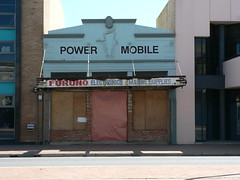 I caught this small shop in St Vincent Street, Port Adelaide in mid-change from a Marine Electronics shop to a Mobile Phone shop in September 2005.
I caught this small shop in St Vincent Street, Port Adelaide in mid-change from a Marine Electronics shop to a Mobile Phone shop in September 2005.
I like the disaster area below the verandah and the beautiul signage above it.
I also like that the shop front is made of wood. Most of the time Art Deco elements are made from concrete but this little shops nods to the Australian past of wooden buildings.
So traditional building technoques are employed even though the original shop owners want to show they are part o the modern world.
I'd like to see what has become of this little place in the last 3 years since I saw it in this state.
Wednesday, February 25, 2009
Firestone Factory, Brentford
We pulled he car off the road so I could jump out and take some photos. The gate above is the first thing I saw. Obviously it was deco but I had no idea exactly what I had come across.The fence along the main road was interspersed every few metres with these stylish pillars.
It was not until I reached the main gates that I was able to confirm what I was beginning to suspect. The F on the gates told me this was all that was left of the Firestone Factory.
Designed by Wallis, Gilbert & Partners in 1928, The Firestone Factory was an Art Deco gem, not unlike the Hoover Factory in Perivale also by Wallis, Gilbert & Partners.
I've read conflicting reports on various websites that the factory was demolished in 1971 or over the August Bank Holiday weekend in 1980 just days before a Preservation Order was going to be enacted.
Certainly the Twentieth Century Society website supports the second version. Gavin Stamp and Alan Powers go on to say that the demolition served as a catalyst to protect 20th C buildings leading directly to the listing of 150 inter-war buildings.The fence and gates are now Grade II Listed which I guess is something and it does serve as a reminder of one of the greatest acts of architectural vandalism.
There are lot more pictures on the delightful Dog and Deco site and if you can face seeing what the building looked like before and as it was being demolished then have a look at www.users.globalnet.co.uk/~garycr/2001/firestone_factory.
[The photo of the original entrance is worth a visit to this site]
Tuesday, February 24, 2009
Blogging Award of Excellence
 The aim of the Excessively Diverting Blog Award is to acknowledge writing excellence in the spirit of Jane Austen’s genius in amusing and delighting readers with her irony, humour, wit, and talent for keen observation. Recipients will uphold the highest standards in the art of the sparkling banter, witty repartee, and gentle reprove. This award was created by the blogging team of Jane Austen Today to acknowledge superior writing over the Internet and promote Jane Austen’s brilliance.
The aim of the Excessively Diverting Blog Award is to acknowledge writing excellence in the spirit of Jane Austen’s genius in amusing and delighting readers with her irony, humour, wit, and talent for keen observation. Recipients will uphold the highest standards in the art of the sparkling banter, witty repartee, and gentle reprove. This award was created by the blogging team of Jane Austen Today to acknowledge superior writing over the Internet and promote Jane Austen’s brilliance.
Today I was nominated to receive an Excessively Diverting Blog Award by Hels at ART and ARCHITECTURE, mainly. Thanks Helen, I've found your posts entertaining and informative.
My nominations are ...
1) In Lost City, Brooks of Sheffield documents the remnants of old New York that are disappearing under the never-ending rush of progress or hang on through good luck or good judgement despite the odds.
2) Richard Nickel jr subtitles the The Kingston Lounge as Guerrilla preservation and urban archaeology. Brooklyn and beyond. He shows once wonderful buildings that are under threat of demolition or suffering demolition by neglect ie left to rot.
3) The Mindful Walker, Susan DeMark, urges us to take our time and explore and enjoy the buildings and streets of our neighbourhoods in this fabulous blog. Susan concentrates on New York City but also looks at the hudson Valley and places further afield.
4) Mo has been bringing Fresh eyes on London since mid 2007 showing London from the point of view of someone new to the city.
5) In a similar way to Lost City, Adam writes about the parts of Paris that others ignore in Invisible Paris.
6) I love the name and I love the attitude. In sit down man, you're a bloody tragedy, Owen Hatherley has an opinion on many things and he is not afraid to let you know where he stands. I await his reaction to this nomination with some dread.
7) My final nomination is Chris Boyd's The Morning After: Performing Arts in Australia. Chris brings his personal, yet professional reviews, of drama, dance, opera and music from around Australia all with a wicked sense of humour. Another reaction to this nomination that I approach with some dread.
Recipients, please claim your award by copying the HTML code of the Excessively Diverting Blog Award badge, posting it on your blog, listing the name of the person who nominated you, and linking to their blog. Then nominate seven (7) other blogs that you feel meet or exceed the standards set forth. Nominees may place the Excessively Diverting badge in their side bar and enjoy the appreciation of their fellow blogger for recognition of their talent.
Thanks to all my nominations. I have enjoyed reading your work and thansk again to Helen for nominating me in the first place.
Monday, February 23, 2009
Mutual Building, Cape Town
The Mutual Building, the former headquarters of the Old Mutual company in Cape Town, is a huge skyscraper in downtown Cape Town. Dating from 1939, it was designed by F M Glennie and Louw & Louw.
The building features many decorative features including elephants and baboons heads on the upper levels and an amazing frieze around the whole building just above street level showing the history of the colonisation of South Africa. The interior is also richly decorated.  Today though, I want to concentrate on the series of nine reliefs on the side of the building depicting the black tribal groups of southern Africa.
Today though, I want to concentrate on the series of nine reliefs on the side of the building depicting the black tribal groups of southern Africa.
The carvings are exquisite and have been executed in great detail.
Each one is named although several are somewhat out of date.
If you want to know more about the peoples of southern Africa, particularily the black tribal groups, the South African Tourism website has an excellent write-up.
The tribal groups shown from left to right are :-
Sunday, February 22, 2009
Flats, Worthing
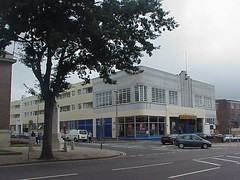 This wonderful streamline Art Deco entrance belongs to a large block of flats in Worthing, in the south of England.
This wonderful streamline Art Deco entrance belongs to a large block of flats in Worthing, in the south of England.No doubt it once had a flagpole as can be seen in the entrance to the commercial part of the building around the corner.
I don't know what business originally occupied that part of the building but as you can see back in 2000 it was a Blockbuster Video store and as far as I know it still is.
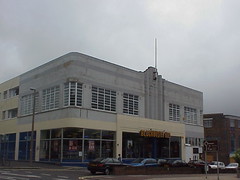 The raw concrete and upper floors of the flats have been painted white since I was there as can be seen in Alan Cooper's 2006 photo on http://www.geograph.org.uk.
The raw concrete and upper floors of the flats have been painted white since I was there as can be seen in Alan Cooper's 2006 photo on http://www.geograph.org.uk.There would be a nice sense of irony if this had once been a cinema, now a Blockbuster Entertainment store but it looks more like a showroom with lots of glass on both floors.
Saturday, February 21, 2009
Gladstone Chambers, Napier
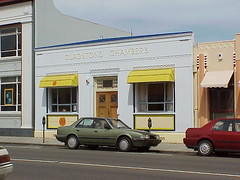 The Gladstone Chambers in Tennyson Street, Napier is a simple single storey building like many constructed immediately following the 1931 earthquake.
The Gladstone Chambers in Tennyson Street, Napier is a simple single storey building like many constructed immediately following the 1931 earthquake.
The Art Deco Inventory compiled by the Art Deco Trust and Napier City Council lists Finch & Westerholm as the architects with construction being completed in 1932.
Gladstone Chambers has very little decoration along the roofline, normally a mainstay of Art Deco buildings. The lettering in the name, set on the facade, is very simple with a decorative row of semi-circles interspersed with pendant shapes.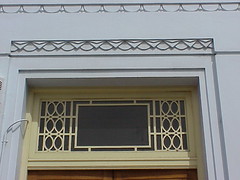 Above the doorway and each of the two windows there is a more complex design consisting of rounded shapes layered with two sizes of triangles.
Above the doorway and each of the two windows there is a more complex design consisting of rounded shapes layered with two sizes of triangles.
The building also features a decorative grill on the window above the door.
Yet another arrangement of geometric shapes provide the decoration in the recessed rectangular panels under the windows.
At the very base of the building the vents at footpath level are very stylish and as can be see in the photo below are placed below the windows according to the deco rule of three.
Friday, February 20, 2009
Avram Villa, Asmara
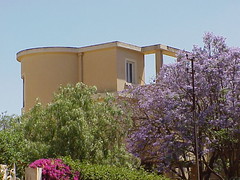 A glimpse of the Avram Villa in Asmara well hidden behind the purple flowers of the Bougainvillea grwoing over the walls of the property.
A glimpse of the Avram Villa in Asmara well hidden behind the purple flowers of the Bougainvillea grwoing over the walls of the property.
According to the Lonely Planet Ethiopia, Eritrea & Djibouti guidebook, Avram Villa was built for the L'Atilla family in the 1930s.
LP also refer to the unusual 'surfboard' loggia on the rooftop terrace. 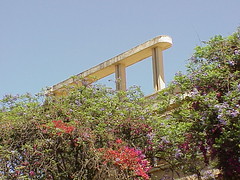
Reference:
Lonely Planet, Ethiopia, Eritrea & Djibouti ~ Frances Lindsay Gordon, 1st Ed, November 2000

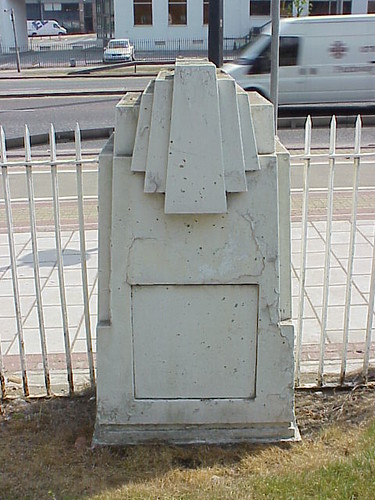
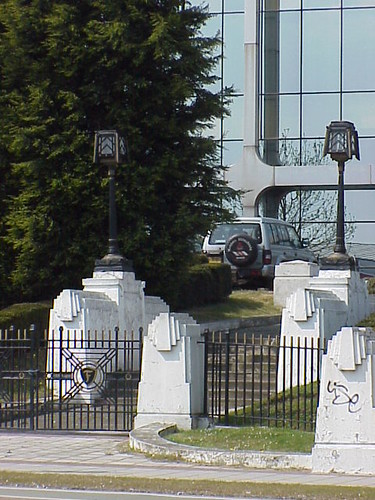
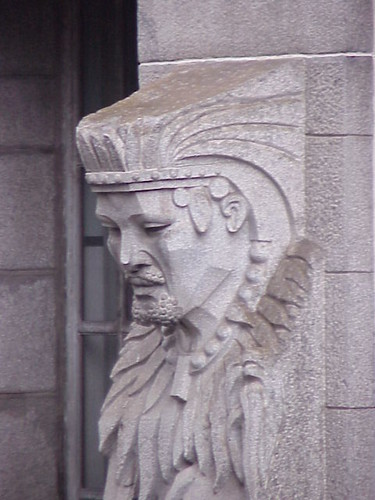
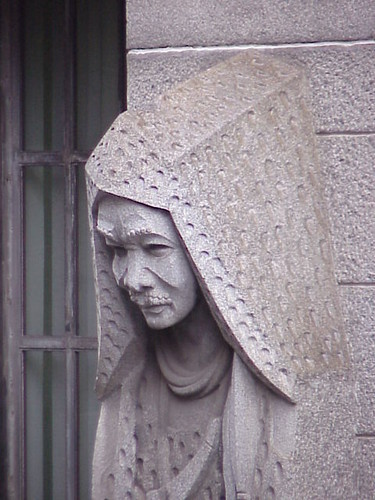
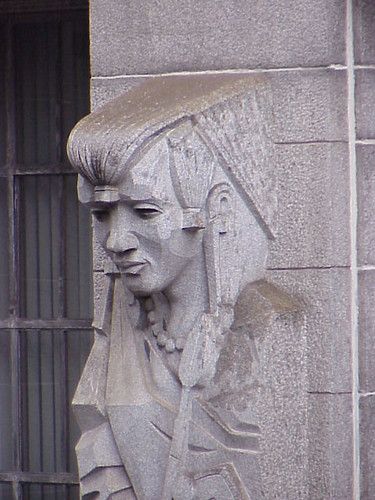
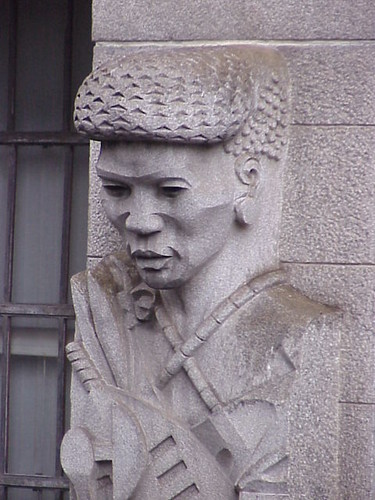

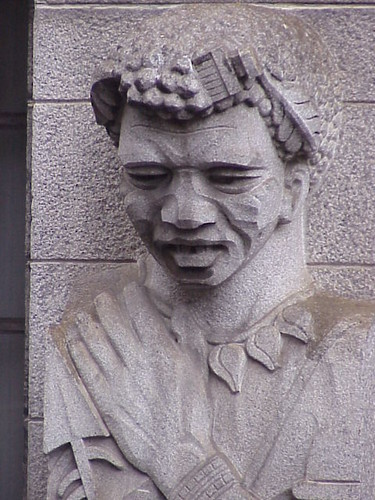
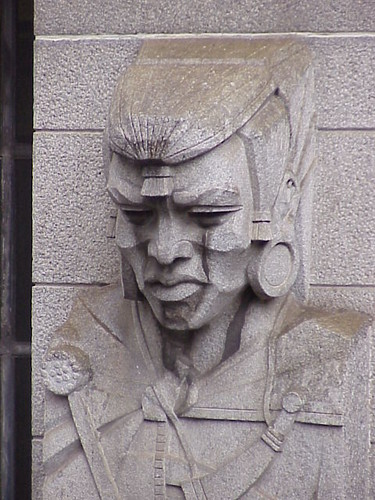
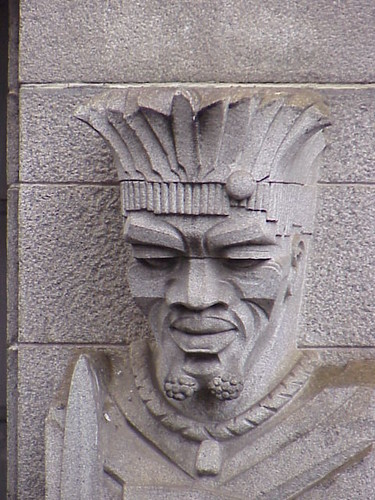


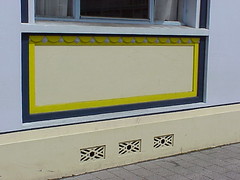








































.jpg)














